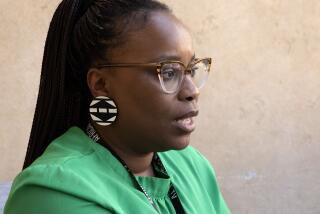COVER STORY : . . . And on to Soweto for the Final Scenes
JOHANNESBURG, South Africa — After all those years of talking about it, reading about it and boycotting it with his films, Spike Lee made the trek to South Africa, the storied symbol of black oppression.
Lee spent four days in South Africa last week to shoot the closing scenes for “Malcolm X” in the streets of Soweto, the sprawling black township of 2.2 million people just outside Johannesburg.
It was a working trip, but also a personal journey for Lee to see for himself what apartheid had wrought and talk to black South Africans--African-American to African--about racism and how to fight it.
Sitting on the third floor of a dilapidated downtown building, bearded chin in hand, he scanned the faces of 50 black film students who had just seen “Do the Right Thing” and its author for the first time.
“Mr. Lee,” a young student began, “there is a feeling that your films encourage racism. What’s your response?”
“Spike,” asked another, “what are you trying to say with ‘Do the Right Thing’? That if your block and your community is under siege, you are supposed to burn the whole place down?”
“Mr. Lee,” chimed in a third, “why are you denying South Africans the opportunity to see your films? I feel South Africa is a definite target country for your messages.”
Lee answered with characteristic bluntness, but also with the genuine empathy that has made him a rare, unqualified hero in the eyes of most black South Africans.
“I don’t know how one can be called a racist for pointing out racism in America today,” he said, dispatching the first questioner.
The point of “Do the Right Thing,” he told the second, is “it’s always one little incident that sets off people who only need one little spark to explode.”
As for his personal film boycott, he said that the major black groups in South Africa asked him not to show his films here, and “I obeyed their wishes.”
Although Malcolm X never made it to South Africa, Lee set the final scenes of his film about the slain black activist in the present day and in Soweto, the largest township. He said he saw Soweto as a modern-day battlefield for the ideals of Malcolm X.
“It doesn’t mean (anything) that Malcolm X didn’t come to South Africa,” Lee told a news conference. “Malcolm saw a connection between black people all over the world, and colored people all over the world.”
Soweto’s squatter camps and thousands of matchbox houses left its mark on Lee. After two days of filming there, he said the conditions were “unbelievable. It’s a ghetto, a concentration camp. What you see on television and read does not convey the reality.”
Seeing the township, he said, made him feel like “I want to take out a gun and shoot someone.”
When he arrived, the white-controlled media were cheering the arrival of American entertainers Paul Simon and Whoopi Goldberg. They were positive proof, the newspapers said, that South Africa’s cultural isolation was ending.
Simon was in the midst of a five-concert tour of the country, and Goldberg was filming “Sarafina” in Soweto. Both also were being feted at fancy homes in the suburbs by Nelson Mandela and the American ambassador, to name just two.
But Lee came without fanfare. He arrived three hours late on a flight from Athens, delayed by a bomb threat on the plane. Once here, he was escorted around town in a modest Toyota. There was no embassy cocktail party. And always, his face bore the unmistakable look of a man who didn’t like what he was seeing.
Simon’s concert tour had run into a head wind of controversy generated by disagreements among blacks about whether he should have come in the first place. But Lee was quietly and warmly embraced by black South Africans.
The South African actor John Kani, who has appeared on Broadway in Athol Fugard’s acclaimed plays, presented Lee with a shield as a welcoming gift and called him “one of the greatest warriors from the African continent.”
The Azanian People’s Organization (AZAPO), which had strongly opposed Simon’s visit and only belatedly OK’d Goldberg’s, never had any reservations about Lee.
His credentials “in furtherance of the black agenda for liberation are beyond doubt,” AZAPO said. “We in AZAPO hold his fight against racism in high esteem and hope his interaction with local artists would have a lasting impression for the struggle.”
Oupa Ramachela of the African National Congress’ arts and culture department praised Lee’s “impeccable track record as an artist committed to our struggle.” And Ramachela said Lee had “unwittingly become a unifying figure in black politics in this country.”
Rapitsi Montsho, one of South Africa’s leading black filmmakers, predicted that Lee’s journey here would be “a catalyst. It will bring a new era of protest filmmaking to South Africa.”
Asked what he, as a successful and wealthy black American filmmaker, had in common with black South Africans, Lee said simply: “We are all brothers.”
One of the film students asked later, why did Lee choose Soweto rather than another, worse off, township?
“Just as Harlem is the mecca for blacks in the United States, Soweto is the mecca for blacks here,” he said, marking himself as a visitor by pronouncing the township “so-WAY-toe” rather than the preferred “so-WEH-toe.”
“And in the end, I was trying to tie Harlem and South Africa together,” Lee added. “You talk about Soweto in the United States and people know.”
Despite his decision to ease his own personal boycott of South Africa by paying the country a visit, Lee said his ban on South African release of his films--written into his contracts--would remain, at least for now.
“We’ll see what happens,” Lee said. “I still reserve the right to show my films here or not show my films here.”
Although Lee admitted that he was not an expert on South African politics, he gave his audience of film students a few lessons in how to escape the shackles of a racist society and how to make films with a political message that sell.
“It’s going to be a struggle for you, just like it was a struggle for us in America, “ Lee said. “It’s not going to change overnight. Maybe you won’t make it, but the young brother behind you will. The only reason I’m able to sit here now is because of the people who went before. Ossie Davis. Gordie Parks. Eddie Murphy.”
“So this huge success we have had makes it easier for that next person who comes through that door,” he added.
A student asked how Lee melded his message into his films.
“First and foremost, I try to tell a good story,” he replied. “No matter what you want to say, if you don’t shape it around a good story, then it’ll be a failure. That’s the most important thing that young filmmakers have to learn, is how to tell a good story.”
Some of the students raised objections to his portrayal of blacks in “Do the Right Thing,” complaining that he showed them as drunk, shiftless and violent people.
“Look, we have to be truthful,” Lee said. “When you have a character who is drunk, it’s not saying all blacks are like that. But alcoholism is a problem in the black community in America. Black females contract AIDS more than any other group. There are more black teen pregnancies than any other group. Black people kill each other more than any other group.
“There are the realities. We can’t stick our heads in the sand and say, ‘Oh, well, if we do that, then we are saying black people live and black people act a certain way.’ I mean, we shouldn’t act like we’re all the Huxtables and Bill Cosby.”
After posing for a photo with the students, Lee headed for Soweto again, leaving his audience impressed and respectful, but with a vague feeling that this black man from America wasn’t much like them.
“I have quite a lot of respect for him as a filmmaker,” said Dennis Mashabela, who makes TV advertisements for a black-owned agency in Johannesburg. “He obviously has strong convictions about black life. And he does have a political agenda, even though he doesn’t admit it.”
And of Lee himself?
“He’s like most Americans,” Mashabela said. “A little cocky and arrogant.”
More to Read
Only good movies
Get the Indie Focus newsletter, Mark Olsen's weekly guide to the world of cinema.
You may occasionally receive promotional content from the Los Angeles Times.











